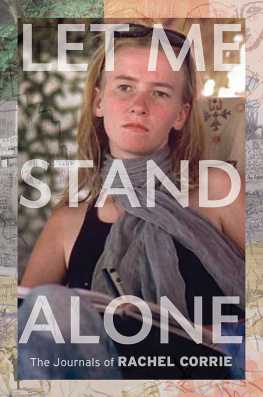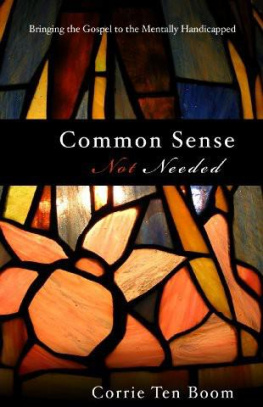The Five Silent Years of Corrie ten Boom
Requests for information should be addressed to:
Zondervan Publishing House
Grand Rapids, Michigan 49530
Copyright 1986 by The Zondervan Corporation
Grand Rapids, Michigan
ePub Edition December 2015: ISBN 978-0-3103-4687-6
Library of Congress Cataloging in Publication Data
Rosewell Moore, Pamela.
The five silent years.
1. Ten Boom, Corrie. 2. Christian biographyNetherlands. I. Title.
BR1725.B6724R67 1986 269.20924 [B] 85-26350
ISBN 0-310-61121-0
All Scripture quotations, unless otherwise noted, are taken from the HOLY BIBLE: NEW INTERNATIONAL VERSION (North American Edition). Copyright 1973, 1978, 1984, by the International Bible Society. Used by permission of Zondervan Bible Publishers.
Other Scripture quotations are from The Living Bible, copyright 1971 by Tyndale House Publishers, Wheaton, Illinois.
Credit is gratefully acknowledged for My Life Is Like a Weaving by Grant Colfax Tullar, quoted in Chapter 3, and to Christian Literature Crusade, Fort Washington, Pa., for permission to quote from A Prisoner and Yet.... in Chapter 9.
All rights reserved. No part of this publication may be reproduced, stored in a retrieval system, or transmitted in any form or by any meanselectronic, mechanical, photocopy, recording, or any otherexcept for brief quotations in printed reviews, without the prior permission of the publisher.
Edited by David Hazard
Designed by Ann Cherryman
96 97 98 99 00 01 /  DH / 26 25 24 23 22 21 20 19 18 17
DH / 26 25 24 23 22 21 20 19 18 17
CONTENTS
The following pages describe the final years of the life of Corrie ten Boom and some of the glimpses I had into the mysteries of life and death.
She and those of us privileged to serve her were the recipients of much love and practical help during the five years of Tante Corries illness. So many were the givers of the help that they are largely unnamed in this book.
To them and to John Sherrill, David Hazard, and Jane Campbell, whose editorial gifts helped me to express the lessons of the silent years, I want to extend very deep gratitude.
1.
A Time to Plant
My Work with Tante Corrie Begins
There is a time for everything, and a season for every activity underheaven.
Ecclesiastes 3:1
It was early spring in 1976 as I drove west toward the city of Haarlem, Holland, a bunch of yellow tulips in the otherwise empty passenger seat beside me in the small French car. The wind was blowing, as it always does in the lowlands, stirring the new, light green growth on the straight rows of poplar trees intersecting the flat countryside. I was aware of the extraordinary light that is peculiar to Hollandcaused perhaps by the large expanse of sky in the absence of hills. This brightness, it is said, inspired the Dutch painters, famous for their use of light. I opened the car window a few inches. The air was fresh and cold and smelled of spring. A feeling of new beginnings was in the air. And since the surprise phone call a few days earlier, I wondered if there was to be a new beginning for me, too.
Traffic was light, leaving me time for reflection. Ever since arriving in The Netherlands from my home in England more than seven years before, I had been fascinated by the Dutch. It had been necessary to learn their language and that was a challenge. Whereas the British would have been more likely to try to spare the feelings of those struggling with a new language, the Dutch, in my first year in the country, had often greeted my efforts to pronounce their guttural consonants and learn their expressions with shouts of honest laughter. You always knew where you were with them.
They invariably described their character as eigenwijs (stubborn), and they pronounced the word with considerable pride. I liked them very much and I loved my exciting work with a mission organization whose principal purpose was to take Bibles behind the Iron Curtain. Life in Holland had been a challenge and an adventure for me up until this point.
And now, after working with that mission for seven-and-a-half years, I was on my way to an interview that would possibly lead to another kind of work. Corrie ten Boom, 83 years old, had asked me to come to her home in a suburb of Haarlem to talk with her. She was looking for another companion, as Ellen de Kroon, who had been with her nearly nine years, was leaving to be married. It had been some time since I had last seen Tante Corrie (Tante, pronounced tahntuh, is the Dutch word for aunt), but we were not strangers, for upon my arrival in Holland she had been one of the first people I had met. Child, she had said, my home is your home. You are always welcome here. I had taken her at her word and had been to visit her during her short stays in The Netherlands in the following years. She spent most of her time outside the country as a tramp for the Lord, to use her words, but during our brief encounters I had grown to love and respect her and was able to help her from time to time.
The straight rows of poplar trees, like long plumes, flashed past the windows. Countryside was turning to town. It would not be long now before I entered Haarlem, and I had to admit to mixed feelings. Although on the one hand the feeling of new adventure was in the air, I doubted that I was a suitable candidate for the role of companion.
Corrie ten Boomhow well did I really know her? She was a world figure who had hidden Jews during the Nazi occupation of Holland and was put in prison and concentration camp for doing so. Had that brave action made her who she was? What made Corrie, Corrie? What had her early years been like?
As I approached Haarlem, the Saint Bavo Cathedral dominated the skyline and looked sedately down on the centuries-old, busy little city. This was the town in which Corrie had grown upin the happy home of watchmaker Casper ten Boom, his wife Cor, Corries two sisters, Betsie and Nollie, and a brother, Willem. She had been born in Amsterdam on April 15, 1892, and could trace her family tree through at least eight generations to 1647 when Jan ten Boom lived at Ruurlo. In 1844 an event took place that was most unusual for its time. Corries grandfather, Willem ten Boom, started a prayer meeting for Jewish people. Tante Corrie often referred to it as a not-to-be-understood answer to my familys prayers for the Jews, for exactly one hundred years later God allowed my whole family to be arrested for their part in saving Jewish people during the Second World War.
Her relationship with the God of her forefathers began at an early age. I had often heard her refer to it. At five years of age I asked the Lord Jesus to come into my heart, she said, and He came, and He has never let me down.
I had now passed the city limits. Traffic was becoming thicker and I had to negotiate the busy streets of Haarlem carefully. Just a few yards from where I was driving, but out of sight, was the Barteljorisstraat. It was to this street, near the cathedral, that the Ten Boom family moved from Amsterdam. Their home was called the Beje (pronounced bay-yay) for short, the name consisting of the initial letters of Bartel Joris, Joris being a fourteenth-century inhabitant of the town of Haarlem.
The Beje was small and, throughout Corries childhood, was full of peoplethe six family members and three aunts, sisters of her mother, Cor. It was, as Tante Corrie described it, full of color, warmth, music, and laughter, and Mother ten Boom always had room for guests at her table. The home had a solid spiritual foundation. The Bible was read daily. A favorite Dutch national pastime is talking, and there was lots of communication and close family unity in the Beje. Corrie constantly looked for ways to share the love and sense of belonging with which she grew up. As a young woman she started several clubs, including a Christian Girl Scout movement called The Triangle Girls and clubs for the mentally retarded.
Next page













 DH / 26 25 24 23 22 21 20 19 18 17
DH / 26 25 24 23 22 21 20 19 18 17